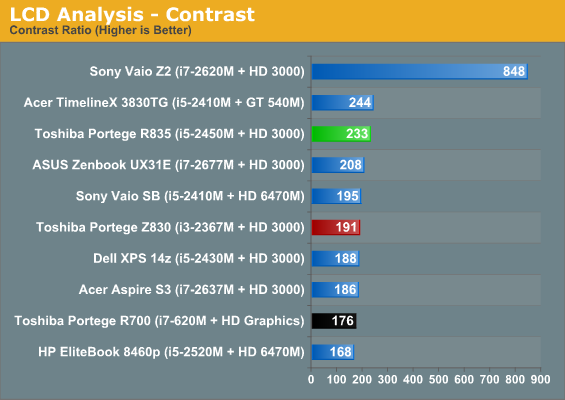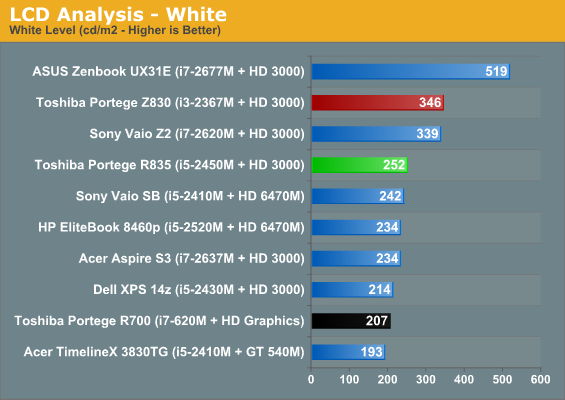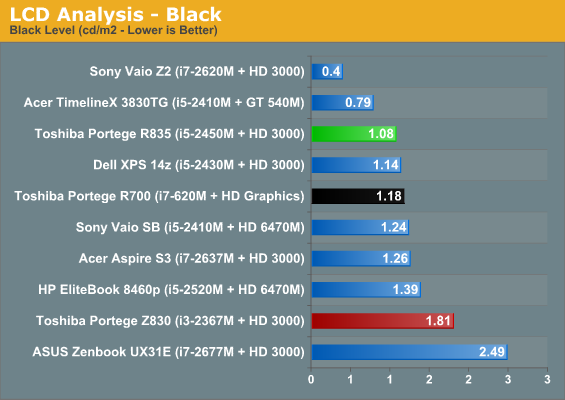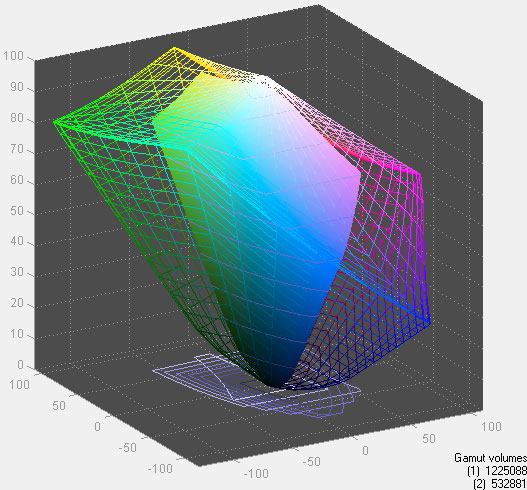Toshiba Portege R835: Less Ultra, More Notebook
by Dustin Sklavos on March 30, 2012 11:35 AM EST- Posted in
- Laptops
- Intel
- Toshiba
- Sandy Bridge
- Notebooks
Another Low Quality TN Panel
I recently enjoyed a meeting with Toshiba reps to discuss their upcoming back-to-school lineup. When asked what my biggest pet peeves were when reviewing notebooks and what bothered me the most, it'll surprise no one to say lousy monitor quality was at the top of my list.
Each time I write about a notebook with a crappy display, more and more people get irate in comments, and many of you simply write off the review. The unfortunate fact of the matter is that hardware like this is still what's prevalent in the marketplace, and that Joe Consumer either doesn't seem to care that much about screen quality or just doesn't know to ask for better. That tide may change with the rise of tablets, but there are people who see text on a high resolution screen, see that it's "too small," and just assume the screen quality is poor. So this problem persists.
Writers here have the unique luxury of being able to interact directly with representatives from the vendors producing these notebooks, and "stop giving us crappy panels" is a banner we continue to wave. In the meantime, though, understand that if we stopped reviewing notebooks with bad panels we'd be down to maybe one notebook review a month, and then you'd just wonder why we're not reviewing laptops.
With that spiel out of the way, it should come as no surprise that the Toshiba Portege R835's display is, once again, pretty bad.






There you have it. Apart from the Vaio Z2's stunning 1080p display (still TN and still suffering from middling viewing angles), what you see above is what the Toshiba Portege R835 has to compete with. It's a broad, industry wide issue. The R835's display isn't really any better or worse than anything else out there that doesn't command a price premium. The 1366x768 display resolution isn't necessarily that bad on a 13.3" screen, but the dire viewing angles, poor contrast, and poor color will always be.
When Apple can stuff a 2048x1536 LCD into the new iPad 2012 for just $499, it's obvious that all we really need is more volume on quality displays and pricing can come down. For that matter, we're not even looking at crazy prices for a decent bump in display quality right now. The stock 1366x768 display in the R835 can be purchased online for just $75, whereas the nicer panel in the Samsung Series 9 appears to go for around $90. Assuming that's the actual panel I've seen in a Series 9 laptop (it's far better than the low-contrast TN panels found elsewhere), $15 extra is a pittance for the improved contrast and brightness. Or how about Apple's vaunted MacBook Air 1440x900 LCD: $100 for a replacement, just $25 more than what we currently have foisted on us.
What it would take is for ASUS, Acer, Dell, HP, Toshiba, etc. to simply start shipping better quality displays for a small bump in price, and we could get rid of the "save $15 for garbage quality" mentality that we're currently living with. Many consumers may not immediately recognize the difference, but the race to the bottom is not doing them any real favors. It's another reason we're frequently inclined to recommend business laptops that cost several hundred dollars more, as the added cost comes with often overlooked items like superior build quality—or in other words, you get what you pay for.










81 Comments
View All Comments
TrackSmart - Friday, April 13, 2012 - link
I have a Toshiba R705. Basically the same laptop, right down to the cooling system design. When running heavy-duty processes (30min of straight number crunching) my CPU core temperatures usually stay in the mid-70s. That's more than 25C below the recommended thermal limit for my processor (105C).I can't imagine any normal usage case, even heavy duty usage, where I would ever get near 105C. I'm guessing the cooling design is okay for all 'normal' usage scenarios, even heavy-duty usage.
That being said, I think that putting all of the intake vents on the bottom of the system is a really dumb idea. If you stream movies with the bottom of the laptop on a bed or sofa - look out! It's going to get toasty in there...
jigglywiggly - Friday, March 30, 2012 - link
please keep talking about lcd quality, I bought my sager np8130 (p151hm1) when you guys spoke about the LCD, it was fairly good and it was great performance for the price and dual link dvi for my 120hz displayhexanerax - Saturday, March 31, 2012 - link
How difficult is it to write a PPI agnostic app? ( to those not in the know,all elements of the UI should appear exactly the same physical size on all monitor resolutions meaning a high ppi display UI looks awesome and this low res junk that manufacturers are hawking will end).Hi res support has to be coded into the os and done right. I have enough problems with un-clickable buttons and unreadable text due to poor dpi scaling in some poorly written apps. Getting correct PPI information from the panel and scaling display elements to actual physical dimensions would be great, allowing users to really see the difference and cough up the extra dough if inclined.
Writing this on a great 1900 x 1200 17" LCD on my Dell Precision M6300 ( never upgraded due to the 16:9 fetish in most product lines.
hexanerax - Saturday, March 31, 2012 - link
$ for $ , an SSD will translate to better user experience than a higher clocked processor for most normal usage scenarios. For those looking for a fast, low priced system, adding a 40 GB SSD and going for a lower clocked cpu or lesser cores will be a better option than a 500 GB 5400 RPM HDD with a high frequency processor. Enthusiast or not an SSD is no longer an option. I can understand using a Mechanical drive for critical data considering the issues that SSDs have had in the past but if you are buying a budget laptop, how critical is the data you are storing? Think cloud storage + SSD for the best experience. Buy an external HDD.On a system with a Corsair Force F120.
jabber - Saturday, March 31, 2012 - link
I don't need more than two USB ports (to be honest I can get by with one).I don't need a Firewire port.
I don't really need a HDMI or D-Sub port either.
I can go without Bluetooth.
That should be nearly enough to get a decent screen instead.
Yeah so one or two USB ports, a gigabit ethernet port and the power port are all I need.
Mumrik - Saturday, March 31, 2012 - link
I'm out...Pylon757 - Saturday, March 31, 2012 - link
Judging from the last picture on the 2nd page, the body appears to be magnesium alloy, not plastic. Mag alloy feels a lot like plastic (especially when painted) since its thermal conductivity is extremely poor and thus doesn't feel cold to the touch (unlike say, aluminum found on Apple's devices)hexanerax - Sunday, April 1, 2012 - link
Just for the record :-http://www.jsw.co.jp/en/mg_f/mg_mg_f/mg_mg_chare.h...
It probably feels less cold because it is conducting heat from the system outwards.
The paint probably has more to do with this feeling than the thermal conductivity of the metal. Aluminum is generally left unpainted ( polished, brushed ) or anodize in color which leaves the thermal properties unchanged.
Mygaffer - Sunday, April 1, 2012 - link
The last time many consumers have seen a monitor with decent image quality was when they were using a CRT.If more consumers could see a side by side of your average TN panel and some of the amazing IPS and PVA panels out there a lot more people would seek out the better monitors. Right now people just don't know any better.
I use two monitors at home, the Dell 3007wfp-HC and a Yamakasi Catleap Q270 (27" S-IPS, same panel as the Apple Cinema display). Both are S-IPS panels, both are very high resolution, and both are amazing. To go back to some lower resolution TN panel now would make me want to claw out my eyes.
Luckily my HP laptop has a very good TN panel in it that even has good viewing angles. One thing that will have to improve a little bit for the high resolution displays to be a good fit for everyone will be better font scaling. Windows 7 has fairly decent support for it and modern browsers also allow some control but it still needs to be improved.
ThreeDee912 - Sunday, April 1, 2012 - link
For better or worse, ultrabooks are coming down in price, and are still using crappy panels.Except for Delta E, and compared to the high-end Sony, it seems like the MacBook Air line from last year still beats most of the panels in these new Ultrabooks:
http://www.anandtech.com/show/5259/ultrabook-head-...